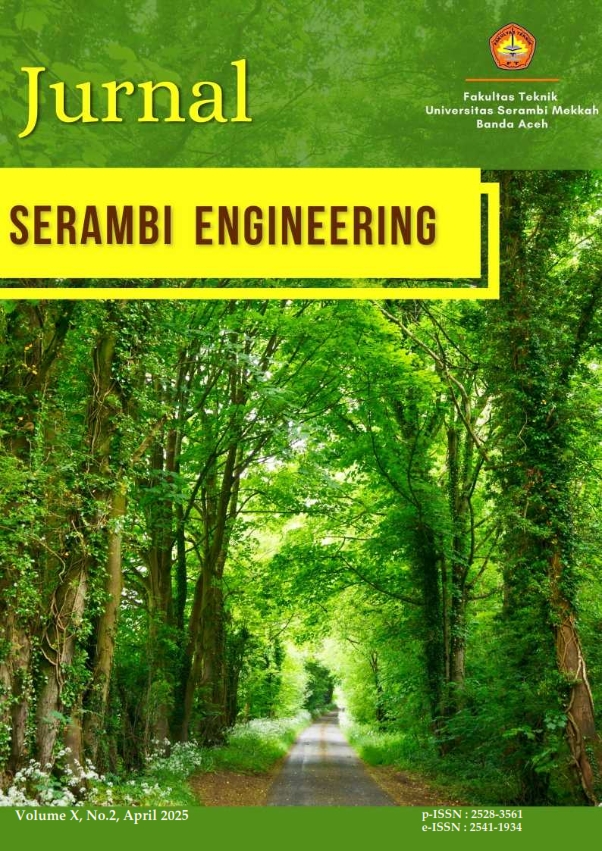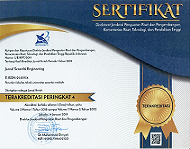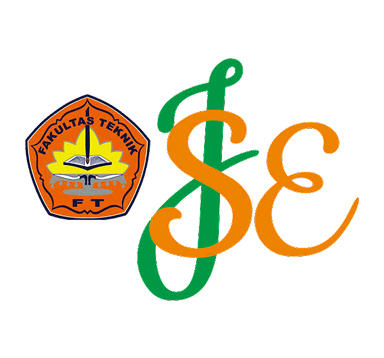Desain Constructed Wetland sebagai Pengolahan Tersier untuk Menyisihkan Mikroplastik
Keywords:
air limbah domestik, Anaerobic Upflow Filter (AUF), constructed wetland, Instalasi Pengolahan Air Limbah (IPAL), mikroplastikAbstract
This study aims to plan the design of a constructed wetland as a tertiary treatment to remove microplastics in wastewater so that it is safe to discharge into water bodies or the environment. The design site is the Anaerobic Upflow Filter (AUF) type wastewater treatment plant in Jambi City. The design uses the Sub Surface Flow Constructed Wetland (SSFCW) system and the Horizontal Sub Surface Flow (HSSF) system with the selected plants being Phragmites communis. The planned design is 1 unit for a treatment capacity of 24 m3/day, which is located downstream of each AUF type WWTP in Jambi City. The constructed wetland design refers to the design criteria and design calculations contained in Book A, a guide for the calculation of fecal sludge treatment buildings. This study also calculates the Bill of Quantity (BOQ), which is determined based on the dimensions of the design drawing, and the Resource Allocation Plan (RAB), which is determined based on the amount of work multiplied by the Analysis of the Unit Price of Work (AHSP). AHSP refers to the Jambi Governor Regulation No. 1 of 2024 on Unit Price Standards. Based on the research results, it was found that the dimensions of the constructed wetland design were 64 m × 16 m × 0.9 m, so the estimated cost for the construction of the design was IDR 405,415,773.84 with an estimated microplastics removal efficiency of 100%.
References
[1] R. Kumar, P. Sharma, C. Manna, dan M. Jain, “Science of the Total Environment Abundance , interaction , ingestion , ecological concerns , and mitigation policies of microplastic pollution in riverine ecosystem : A review,” Sci. Total Environ., vol. 782, hal. 146695, 2021, doi: 10.1016/j.scitotenv.2021.146695.
[2] K. Gunaalan, E. Fabbri, dan M. Capolupo, “The hidden threat of plastic leachates: A critical review on their impacts on aquatic organisms,” Water Res., vol. 184, 2020, doi: 10.1016/j.watres.2020.116170.
[3] L. C. Wang, J. C. Te Lin, C. Di Dong, C. W. Chen, dan T. K. Liu, “The sorption of persistent organic pollutants in microplastics from the coastal environment,” J. Hazard. Mater., vol. 420, no. April, hal. 126658, 2021, doi: 10.1016/j.jhazmat.2021.126658.
[4] G. E. Üstün, K. Bozdaş, dan T. Can, “Abundance and characteristics of microplastics in an urban wastewater treatment plant in Turkey,” Environ. Pollut., vol. 310, no. May, 2022, doi: 10.1016/j.envpol.2022.119890.
[5] S. Hajji, M. Ben-Haddad, M. R. Abelouah, G. E. De-la-Torre, dan A. A. Alla, “Occurrence, characteristics, and removal of microplastics in wastewater treatment plants located on the Moroccan Atlantic: The case of Agadir metropolis,” Sci. Total Environ., vol. 862, no. December 2022, hal. 160815, 2023, doi: 10.1016/j.scitotenv.2022.160815.
[6] World Health Organization, Dieary and Inhalation Exposure to Nano and Microplastic Particles and Potential Implications for Human Health. 2022.
[7] S. Wei dkk., “Characteristics and removal of microplastics in rural domestic wastewater treatment facilities of China,” Sci. Total Environ., vol. 739, 2020, doi: 10.1016/j.scitotenv.2020.139935.
[8] Q. Wang, C. Hernández-Crespo, M. Santoni, S. Van Hulle, dan D. P. L. Rousseau, “Horizontal subsurface flow constructed wetlands as tertiary treatment: Can they be an efficient barrier for microplastics pollution?,” Sci. Total Environ., vol. 721, 2020, doi: 10.1016/j.scitotenv.2020.137785.
[9] Kementerian Pekerjaan Umum dan Perumahan Rakyat, Buku A Panduan Perhitungan Bangunan Pengolahan Lumpur Tinja. Direktorat Jenderal Cipta Karya, 2017.
[10] UN-HABITAT, Constructed Wetland Manual. Kathamandu: UN HABITAT Water for Asian Cities Programme Nepal, 2008.
[11] R. W. Crites, Design Criteria and Practice for Constructed Wetland. Water Science and Technology, 1994.
[12] G. Bendoricchio, L. D. Cin, dan J. Persson, Guidelines for Free Water Surface Wetland Design. Ecosystems, 2000.
[13] Y. Long dkk., “Microplastics removal and characteristics of a typical multi-combination and multi-stage constructed wetlands wastewater treatment plant in Changsha, China,” Chemosphere, 2023, [Daring]. Tersedia pada: https://doi.org/10.1016/j.chemosphere.2022.137199
[14] Y. Chen dkk., “Transport and fate of microplastics in constructed wetlands: A microcosm study,” J. Hazard. Mater., vol. 415, hal. 1–7, 2021, doi: 10.1016/j.jhazmat.2021.125615.
[15] Pemerintah Provinsi Jambi, Peraturan Gubernur Jambi Nomor 1 Tahun 2024 tentang Standar Harga Satuan. 2024.
[16] Y. Chen dkk., “Transport and fate of microplastics in constructed wetlands: A microcosm study,” J. Hazard. Mater., vol. 415, no. March, hal. 125615, 2021, doi: 10.1016/j.jhazmat.2021.125615.
[17] Q. Wang, Y. Li, X. Yang, S. W. H. Van Hulle, dan D. P. L. Rousseau, “Microplastics in two different constructed wetlands systems for wastewater treatment: Removal and fate,” J. Environ. Chem. Eng., vol. 12, no. 6, 2024, doi: 10.1016/j.jece.2024.114341.
[18] N. Baylan, P. Koyuncuoğlu, dan G. Erden, “Microplastics in a horizontal subsurface flow constructed wetland: A Case Study of Denizli/Türkiye,” Ecol. Eng., vol. 207, no. July, 2024, doi: 10.1016/j.ecoleng.2024.107349.
[19] Y. Long dkk., “Microplastics removal and characteristics of a typical multi-combination and multi-stage constructed wetlands wastewater treatment plant in Changsha, China,” Chemosphere, 2023.
Downloads
Published
Issue
Section
License
Copyright (c) 2025 Amalia Viviani, Ansiha Nur, Puti Sri Komala (Author)

This work is licensed under a Creative Commons Attribution 4.0 International License.













